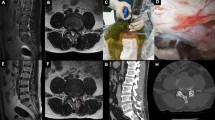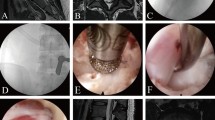Abstract
Objective
The purpose of this study was to investigate the learning curve of percutaneous endoscopic transforaminal discectomy (PETD) and interlaminar unilateral biportal endoscopic discectomy (UBED) in the treatment of lumbar disc herniation (LDH).
Methods
Between 2018 and 2023, 120 consecutive patients with lumbar disc herniation (LDH) treated by endoscopic lumbar discectomy were retrospectively included. The PETD group comprised 87 cases, and the UBED group comprised 33 cases. Cumulative sum analysis was used to evaluate the learning curve, with the occurrence of complications or unresolved symptoms defined as surgical failure, and variables of different phases of the learning curve being compared.
Results
The learning curve analysis identified the cutoff point at 40 cases in the PETD group and 15 cases in the UBED group. In the mastery phase, both PETD and UBED demonstrated a significant reduction in operation times (approximately 38 min for PTED and 49 min for UBED). In both PETD and UBED groups, the surgical failure rates during the learning and mastery phases showed no statistically significant differences. The visual analogue scale at the last follow-up was significantly lower than before surgery in both the PETD and UBED groups.
Conclusion
PETD and UBED surgery are effective in the treatment of LDH with a low incidence of complications. However, achieving mastery in PETD necessitates a learning curve of 40 cases, while UBED requires a minimum of 15 cases to reach proficiency.









Similar content being viewed by others
References
Luo X, Pietrobon R, Sun SX, Liu GG, Hey L (2004) Estimates and patterns of direct health care expenditures among individuals with back pain in the United States. Spine 29(1):79–86
Yoon WW, Koch J (2021) Herniated discs: when is surgery necessary? EFORT Open Rev 6:526–530
Kerr D, Zhao W, Lurie JD (2015) What are long-term predictors of outcomes for lumbar disc herniation? A randomized and observational study. Clin Orthop Relat Res 473:1920–1930
Lorio M, Kim C, Araghi A, Inzana J, Yue JJ (2020) International society for the advancement of spine surgery policy 2019-surgical treatment of lumbar disc herniation with radiculopathy. Int J Spine Surg 14:1–17
Alvi MA, Kerezoudis P, Wahood W, Goyal A, Bydon M (2018) Operative approaches for lumbar disc herniation: A systematic review and multiple treatment meta-analysis of conventional and minimally invasive surgeries. World Neurosurg 114(391–407):e2
Jiang S, Li Q, Wang H (2021) Comparison of the clinical efficacy of percutaneous transforaminal endoscopic discectomy and traditional laminectomy in the treatment of recurrent lumbar disc herniation. Medicine (Baltimore) 100:e25806
Jung B, Han J, Song J, Ngan A, Essig D, Verma R (2023) Interventional therapy and surgical management of lumbar disc herniation in spine surgery: A narrative review. Orthop Rev (Pavia) 15:88931
Kambin P (1989) Percutaneous lumbar diskectomy. JAMA 262:1776
Ren C, Qin R, Li Y, Wang P (2020) Microendoscopic discectomy combined with annular suture versus percutaneous transforaminal endoscopic discectomy for lumbar disc herniation: A prospective observational study. Pain Physician 23:E713–E721
Yang JS, Chu L, Chen CM et al (2018) Foraminoplasty at the tip or base of the superior articular process for lateral recess stenosis in percutaneous endoscopic lumbar discectomy: A multicenter, retrospective, controlled study with 2-year follow-up. Biomed Res Int 2018:7692794
Ozer MI, Demirtas OK (2023) Comparison of lumbar microdiscectomy and unilateral biportal endoscopic discectomy outcomes: a single-center experience. J Neurosurg Spine. https://doi.org/10.3171/2023.10.SPINE23718
Hong YH, Kim SK, Suh DW, Lee SC (2020) Novel instruments for percutaneous biportal endoscopic spine surgery for full decompression and dural management: A comparative analysis. Brain Sci 10(8):516
Quillo-Olvera J, Quillo-Resendiz J, Quillo-Olvera D, Barrera-Arreola M, Kim JS (2020) Ten-step biportal endoscopic transforaminal lumbar interbody fusion under computed tomography-based intraoperative navigation: Technical report and preliminary outcomes in mexico. Oper Neurosurg (Hagerstown) 19:608–618
Kang MS, Chung HJ, Jung HJ, Park HJ (2021) How I do it? Extraforaminal lumbar interbody fusion assisted with biportal endoscopic technique. Acta Neurochir (Wien) 163:295–299
Hao J, Cheng J, Xue H, Zhang F (2022) Clinical comparison of unilateral biportal endoscopic discectomy with percutaneous endoscopic lumbar discectomy for single l4/5-level lumbar disk herniation. Pain Pract 22:191–199
Jiang HW, Chen CD, Zhan BS, Wang YL, Tang P, Jiang XS (2022) Unilateral biportal endoscopic discectomy versus percutaneous endoscopic lumbar discectomy in the treatment of lumbar disc herniation: a retrospective study. J Orthop Surg Res 17:30
Wohl H (1977) The cusum plot: Its utility in the analysis of clinical data. N Engl J Med 296:1044–1045
Fardon DF, Williams AL, Dohring EJ, Murtagh FR, Gabriel Rothman SL, Sze GK (2014) Lumbar disc nomenclature: version 2.0: Recommendations of the combined task forces of the North American Spine Society, the American Society of Spine Radiology and the American Society of Neuroradiology. Spine J 14:2525–45
Qin R, Liu B, Hao J et al (2018) Percutaneous endoscopic lumbar discectomy versus posterior open lumbar microdiscectomy for the treatment of symptomatic lumbar disc herniation: a systemic review and meta-analysis. World Neurosurg 120:352–362
Kim SK, Kang SS, Hong YH, Park SW, Lee SC (2018) Clinical comparison of unilateral biportal endoscopic technique versus open microdiscectomy for single-level lumbar discectomy: a multicenter, retrospective analysis. J Orthop Surg Res 13:22
Ao S, Wu J, Zheng W, Zhou Y (2018) A novel targeted foraminoplasty device improves the efficacy and safety of foraminoplasty in percutaneous endoscopic lumbar discectomy: preliminary clinical application of 70 cases. World Neurosurg 115:e263–e271
Kim HS, Yudoyono F, Paudel B et al (2018) Suprapedicular circumferential opening technique of percutaneous endoscopic transforaminal lumbar discectomy for high grade inferiorly migrated lumbar disc herniation. Biomed Res Int 2018:5349680
Sun B, Shi C, Xu Z et al (2019) Learning curve for percutaneous endoscopic lumbar diskectomy in Bi-needle technique using cumulative summation test for learning curve. World Neurosurg 129:e586–e593
Sun B, Wu H, Xu Z et al (2020) Is selective nerve root block necessary for learning percutaneous endoscopic lumbar discectomy: a comparative study using a cumulative summation test for learning curve. Int Orthop 44:1367–1374
ChaputdeSaintonge DM, Vere DW (1974) Why don’t doctors use cusums? Lancet 1:120–1
Maayan O, Pajak A, Shahi P et al (2023) Percutaneous transforaminal endoscopic discectomy learning curve: A cusum analysis. Spine 48:1508–16
Gadjradj PS, Vreeling A, Depauw PR, Schutte PJ, Harhangi BS (2022) Group PTS. Surgeons learning curve of transforaminal endoscopic discectomy for sciatica. Neurospine 19:594–602
Son S, Ahn Y, Lee SG et al (2021) Learning curve of percutaneous endoscopic transforaminal lumbar discectomy by a single surgeon. Medicine (Baltimore) 100:e24346
Wu XB, Fan GX, Gu X et al (2016) Learning curves of percutaneous endoscopic lumbar discectomy in transforaminal approach at the L4/5 and L5/S1 levels: a comparative study. J Zhejiang Univ Sci B 17:553–560
Ahn SS, Kim SH, Kim DW (2015) Learning curve of percutaneous endoscopic lumbar discectomy based on the period (Early vs. Late) and technique (in-and-out vs. in-and-out-and-in): a retrospective comparative study. J Korean Neurosurg Soc 58:539–46
Xu J, Wang D, Liu J et al (2022) Learning curve and complications of unilateral biportal endoscopy: cumulative sum and risk-adjusted cumulative sum analysis. Neurospine 19:792–804
Chen L, Zhu B, Zhong HZ et al (2022) The learning curve of unilateral biportal endoscopic (UBE) spinal surgery by CUSUM analysis. Front Surg 9:873691
Park SM, Kim HJ, Kim GU et al (2019) Learning curve for lumbar decompressive laminectomy in Biportal endoscopic spinal surgery using the cumulative summation test for learning curve. World Neurosurg 122:e1007–e1013
Choi DJ, Choi CM, Jung JT, Lee SJ, Kim YS (2016) Learning curve associated with complications in biportal endoscopic spinal surgery: challenges and strategies. Asian Spine J 10:624–629
Lee SH, Kang HS, Choi G et al (2010) Foraminoplastic ventral epidural approach for removal of extruded herniated fragment at the L5–S1 level. Neurol Med Chir (Tokyo) 50:1074–1078
Zhang Y, Feng B, Hu P, Dai G, Su W (2023) One-hole split endoscopy technique versus unilateral biportal endoscopy technique for L5–S1 lumbar disk herniation: analysis of clinical and radiologic outcomes. J Orthop Surg Res 18:668
Mysliwiec LW, Cholewicki J, Winkelpleck MD, Eis GP (2010) MSU classification for herniated lumbar discs on MRI: toward developing objective criteria for surgical selection. Eur Spine J 19:1087–1093
Kim W, Kim SK, Kang SS, Park HJ, Han S, Lee SC (2020) Pooled analysis of unsuccessful percutaneous biportal endoscopic surgery outcomes from a multi-institutional retrospective cohort of 797 cases. Acta Neurochir (Wien) 162:279–287
Ao S, Wu J, Tang Y et al (2019) Percutaneous endoscopic lumbar discectomy assisted by o-arm-based navigation improves the learning curve. Biomed Res Int 2019:6509409
Huang X, Liu X, Zhu B et al (2023) Evaluation of augmented reality surgical navigation in percutaneous endoscopic lumbar discectomy: clinical study. Bioengineering 10(11):1297
Funding
This work was supported by the Clinical Research Incubation Program, Beijing Chaoyang Hospital, Capital Medical University, Beijing, China (CYFH202316) and Beijing Municipal Science and Technology Commission Capital Clinical Diagnostic and Treatment Technology Research and Demonstration Application (Z211100002921027).
Author information
Authors and Affiliations
Corresponding authors
Ethics declarations
Conflict of interest
The authors declare that no conflicts of interest in this work.
Additional information
Publisher's Note
Springer Nature remains neutral with regard to jurisdictional claims in published maps and institutional affiliations.
Rights and permissions
Springer Nature or its licensor (e.g. a society or other partner) holds exclusive rights to this article under a publishing agreement with the author(s) or other rightsholder(s); author self-archiving of the accepted manuscript version of this article is solely governed by the terms of such publishing agreement and applicable law.
About this article
Cite this article
Li, Z., Yang, H., Zhang, Y. et al. Percutaneous endoscopic transforaminal discectomy and unilateral biportal endoscopic discectomy for lumbar disc herniation: a comparative analysis of learning curves. Eur Spine J (2024). https://doi.org/10.1007/s00586-024-08293-8
Received:
Revised:
Accepted:
Published:
DOI: https://doi.org/10.1007/s00586-024-08293-8




